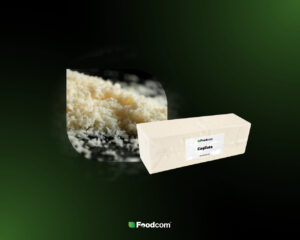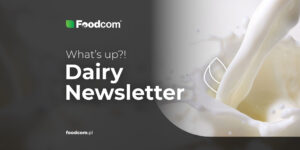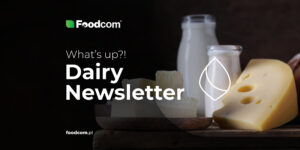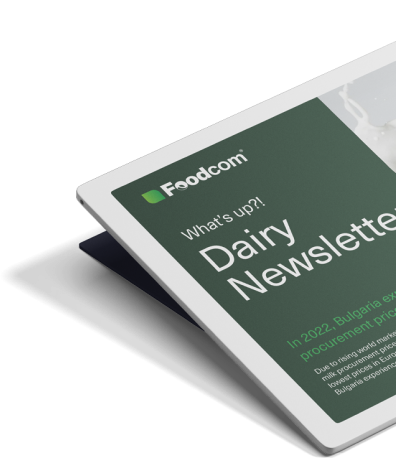- Powdered milk prices in Europe continue to fall, with the market struggling with high stocks and weak export demand.
- In the cheese market, price reductions have affected Gouda, Edam and Cheddar, while Mozzarella and Cagliata remain more stable.
- Butter and milk fats are falling in price along with cream, while liquid components and skimmed milk concentrates are seeing further declines.
- Whey proteins are maintaining higher prices thanks to stable demand.
- The United States is investing in combating the screw fly, the United Kingdom is fighting bluetongue disease, and India is developing breeding technologies to increase milk production.
Welcome Partners!
Welcome back to our newsletter!
The fourth quarter will be challenging for dairy markets. In Europe, powders, cheeses and fats are losing value under the weight of large stocks, and the liquid and whey segments are continuing their declines. Meanwhile, there is a lot going on globally. The US is directing billions into livestock conservation, the UK is grappling with bluetongue and India is betting on new reproductive technologies to boost milk production. Here’s what’s worth knowing this week.
Scroll down for detailed market data and forecasts.
Milk powder
Skimmed milk powder(SMP) prices in Europe have fallen to around €2180-2250/MT. Export demand remains weak and the unfavourable euro/dollar exchange rate limits the competitiveness of EU offers. High supply and rising stocks continue to have a negative impact on the market.
Prices for skimmed milk powder for feed (SMP feed) are slightly lower at €2100-2200/MT. The small difference between food and feed prices indicates oversupply and limited buying activity.
In Oceania, SMP prices have risen to around €2200/MT, supported by stable demand from Asia. In the US, prices are close to EUR 2190/MT. Lower production combined with a favourable exchange rate supports exports and ensures price stability. In Latin America, conditions remain essentially unchanged.
The price of whole milk powder(FCMP) in Europe is EUR 3750-3850/MT, which is higher than suggested by the underlying cost drivers (SMP butter). Consumption remains uneven and demand from the chocolate industry is particularly weak. In Oceania, prices are around €3,200/MT and forecasts for the new season indicate increased milk flows and higher supply in the second half of the year, which could put additional pressure on world prices.
Cheese
The cheese market in Europe continues to show a downward trend. Gouda and edam cheese prices have fallen below €3400/MT, while mozzarella is trading at around €3250-3350/MT. High stock levels and limited export activity remain the main factors influencing the market.
Of the main varieties, mozzarella is performing best, supported by seasonal demand from catering, although the overall market situation remains challenging. European cheddar prices have fallen below €3950/MT, confirming continued weakness.
Cagliata in Europe is holding steady at prices currently around €3700-3850/MT. Demand from cheese and pizza producers remains stable, helping to balance the market. However, the abundant availability of raw milk is limiting the potential for price increases and purchases are mainly concentrated on short-term contracts.
Producers are shifting volumes between markets to avoid stockpiling in Q4. In Oceania, prices are showing a slight increase, in contrast to the decreases seen in Europe. In the United States, cheddar cheese producers are enjoying a price advantage over producers in Europe and Oceania, increasing export potential.
Fats
Butter prices in Europe have fallen to €5300-5500/MT. The market is under pressure from higher production and imports, while exports have fallen significantly. Surpluses from the first half of the year continue to affect the balance, with most transactions taking place at the lower end of the price range.
Lower cream prices further reinforce the downward trend, lowering butter production costs and increasing selling pressure. The spot market is clearly weakened and sellers are increasingly accepting lower prices to maintain liquidity. Further falls are expected in the short term, although the pace may be slower than in recent weeks.
The European market for anhydrous milk fat(AMF) is relatively balanced, with prices in the €6700-6900/MT range. Demand from industrial users and export markets remains stable, partially offsetting the pressure seen in butter. However, no significant surpluses are being created and most volumes are sold under contract rather than on the spot market.
Liquids
Cream prices in Europe have fallen to EUR 5800-6000/MT, a further decline compared to recent weeks. This has also translated into lower butter prices per cream equivalent.
Skimmed milk concentrate(SMC) prices are at EUR 1600-1800/MT, although some transactions are reported at prices closer to EUR 1500/MT. The market clearly differentiates between quality: batches with higher protein content achieve prices at the upper end of the range, while lower quality products are sold at prices closer to the lower end.
The liquid product segment in Europe is shaped by an increased supply of raw milk and limited purchasing activity. In the short term, prices are likely to remain under a downward trend with no clear signs of a rapid recovery.
Whey powder
Whey prices in Europe continue to decline. Food whey remains below EUR 1,000/MT, while feed whey is priced at around EUR 800-850/MT. Over-supply and weak export demand, particularly from Asia, are keeping pressure on the market. Producers are increasingly redirecting volumes to higher value protein fractions such as whey protein concentrate(WPC) and whey protein isolate (WPI).
Whey protein concentrate 80%(WPC80) prices are stable. In Europe they are around EUR 12,000/MT, while in the US they are significantly lower at around EUR 9200/MT. Most volumes for Q3 have already been contracted and offers for Q4 are gradually increasing. The growing interest in contracts for 2026 signals continued long-term demand.
Whey protein isolate (WPI) is on an upward trend. In Europe, prices are in the range of EUR 19 600 to EUR 19 800/MT, while in the US they are around EUR 18 000/MT. The recovery in demand, coupled with expectations of a reduction in supply, is supporting this upward trend and producers are already testing higher levels in Q4 offers.
The permeate market remains weak. In Europe, prices are around €800/MT, while in the US they are around €480-500/MT. Lactose is also losing value after a period of stabilisation. A decline of more than 50% in Chinese imports has dampened sentiment, although stronger demand from Latin America and Southeast Asia is providing partial support for US exports.
What’s new
United States
The US will allocate one billion dollars to protect livestock from the screw fly. A facility is being built in Texas to produce sterile flies. Insects released into the environment will interbreed with wild flies, producing infertile eggs and gradually eliminating the pest population. The screw fly is extremely dangerous because its larvae develop in the wounds of live animals and destroy healthy tissue, which can lead to disease and even death in cattle. The US is also increasing cooperation with Mexico, which has lifted tariffs on equipment needed to control the pest and allowed sterile flies to be dropped from the air in border areas. This strategic combination of capital, technology and cross-border cooperation aims to ensure the long-term protection of global livestock production from one of the most dangerous parasites.
UK
Bluetongue has been a serious threat to livestock farming in Wales for months. Restrictions on livestock movements were introduced in June and July, and in recent weeks additional restrictions have been imposed on transport from England, where new cases of infection have been detected. The virus is transmitted by midges, so the risk of the disease spreading across borders remains very high. Some restrictions have been relaxed since 21 September, but only animals vaccinated against BTV-3 serotype can be brought into Wales and the transport of unvaccinated animals requires a special permit. The disease is dangerous because the virus damages tissue and can lead to high mortality rates in herds. Its name comes from the characteristic blue colouration of the tongue in infected animals. The authorities stress that vaccination remains key to protecting livestock production and market stability, but so far most farmers have chosen not to use it.
India
India is investing in technology that could revolutionise dairy farming. In the state of Bihar, a state-of-the-art station using sexing sorting technology that achieves up to 90% accuracy in producing female calves has been launched. In practice, the semen of bulls is sorted into X and Y sperm and then prepared into insemination doses, which are delivered to breeders. The new facility, operating under the Rashtriya Gokul Mission programme, has the capacity to produce hundreds of thousands of such doses per year, and the ‘Gausort’ technology developed in India keeps costs affordable. As a result, more heifers are produced, which directly translates into higher milk production and more stable incomes for farmers. The project is particularly important for small farmers and landless workers whose livelihoods are largely dairy farming. It is an example of how targeted technological innovation can strengthen the local economy and inspire other developing markets.
![Dairy prices are falling, but the dairy market is not slowing down [281st Edition of DAIRY Newsletter] Dairy prices are falling, but the dairy market is not slowing down [281st Edition of DAIRY Newsletter]](https://foodcom.pl/wp-content/uploads/2024/06/Foodcom_SA_Dairy_Newsletter_4-1520x760.jpg)






